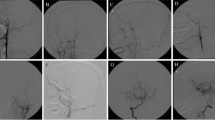Abstract
Introduction
Pediatric Moyamoya disease is rarely associated with intracranial aneurysms. We report a case of a 7-year-old girl with an antecedent of persistent craniopharyngeal canal, who presented with a history of choreiform movements.
Materials and methods
A Moyamoya disease was found with an unruptured left middle cerebral artery aneurysm on her first angiography. Conservative treatment was chosen for the aneurysm and she underwent indirect revascularization by encephalosynangiosis using the multiple bur-hole technique for her Moyamoya disease. Abnormal movements were improved. Control angiogram at 6 months showed development of intracranial–extracranial anastomoses with complete resolution of the aneurysm. Aneuryms including the major arteries of the basal arterial circle occur as a by-product of the high velocity and blood flow secondary to the arterial stenosis. Blood flow modification after revascularization often lead to spontaneous regression and disappearance of these aneurysms.
Conclusion
Therefore, a conservative treatment of these proximal aneurysms must be chosen after encephalosynangiosis.






Similar content being viewed by others
References
Ali MJ, Bendock BR, Getch CC, Gottardi-Littell NR, Mindea S, Batjer HH (2004) Surgical management of a ruptured posterior choroidal intraventricular aneurysm associated with Moyamoya disease using frameless stereotaxy: case report and review of the literature. Neurosurgery 54:1019–1024
Arey LB (1950) The craniopharyngeal canal reviewed and reinterpreted. Anat Record 106:1–16
Borota L, Marinkovic S, Bajic R, Kovacevic M (1996) Intracranial aneurysms associated with Moyamoya disease. Neurol Med Chir (Tokyo) 36:860–864
Kagawa K, Ezura M, Shirane R, Takahashi A, Yoshimoto T (2001) Intraaneurysmal embolization of an unruptured basilar tip aneurysm associated with Moyamoya disease. J Clin Neurosci 8:462–464
Kawaguchi S, Sakaki T, Morimoto T, Kakizaki T, Kamada K (1996) Characteristics of intracranial aneurysms associated with Moyamoya disease: a review of 111 cases. Acta Neurochir (Wien) 138:1287–1294
Kim CY, Wang KC, Kim SK, Chung YN, Kim HS, Cho BK (2003) Encephaloduroarteriosynangiosis with bifrontal encephalogaleo(periosteal)synangiosis in the pediatric Moyamoya disease: the surgical technique and its outcomes. Childs Nerv Syst 19:316–323
Kim DS, Kang SG, Yoo DS, Huh PW, Cho KS, Park CK (2007) Surgical results in pediatric Moyamoya disease: angiographic revascularization and the clinical results. Clin Neurol Neurosurg 109:125–131
Kim SK, Wang KC, Kim IO, Lee DS, Cho BK (2002) Combined encephaloduroarteriosynangiosis and bifrontal encephalogaleo(periosteal)synangiosis in pediatric Moyamoya disease. Neurosurgery 50:88–96
Koebbe CJ, Horowitz MB (2004) A rare case of a ruptured middle meningeal aneurysm causing intracerebral hematoma in a patient with Moyamoya disease. AJNR Am J Neuroadiol 25:574–576
Konishi Y, Kadowaki C, Hara M, Takeuchi K (1985) Aneurysms associated with Moyamoya disease. Neurosurgery 16:484–491
Nagata S, Matsushima T, Morioka T, Matsukado K, Mihara F, Sasaki T, Fukui M (2006) Unilaterally symptomatic Moyamoya disease in children: long-term follow-up of 20 patients. Neurosurgery 59:830–837
Nishimoto T, Yuki K, Sasaki T, Murakami T, Kodama Y, Kurisu K (2005) A ruptured middle cerebral artery aneurysm originating from the site of anastomosis 20 years after extracranial–intracranial bypass for Moyamoya disease: case report. Surg Neurol 64:261–265
Okuma A, Oshita H, Funakoshi T, Yamada H (1980) A case of aneurysm in the cerebral Moyamoya vessel: aneurysmal rupture during cerebral angiography and spontaneous regression of the aneurysm. No Shinkei Geka 8:181–185
Park JH, Yang SY, Chung YN, Kim JE, Kim SK, Han DH, Cho BK (2007) Modified encephalodurosynangiosis with bifrontal encephalogaleoperiostal synangiosis for the treatment of the pediatric Moyamoya disease: technical note. J Neurosurg 106(3 Suppl Pediatrics):237–242
Pool JL, Wood EH, Maki Y (1967) On the case with abnormal vascular network in the cerebral basal region in the United States. In: Kudo Y (ed) A disease with abnormal intracranial vascular network. Spontaneous occlusion of the circle of Willis. Igaku Shoin, Tokyo, pp 63–68
Sainte-Rose C, Oliveira R, Puget S, Beni-Adani L, Boddaert N, Thorne J, Wray A, Zerah M, Bourgeois M (2006) Multiple bur hole surgery for the treatment of Moyamoya disease in children. J Neurosurg 105(6 Suppl Pediatrics):437–442
Scott RM, Smith JL, Robertson RL, Madsen JR, Soriano SG, Rockoff MA (2004) Long-term outcome in children with Moyamoya syndrome after cranial revascularization by pial synangiosis. J Neurosurg (Pediatrics 2) 100:142–149
Soto-Ares G, Hamon-Kerautret M, Leclerc X, Vallée L, Pruvo JP (1996) Moyamoya associated with Down syndrome [article in French]. J Radiol 77:441–444
Suzuki J, Takaku A, Kodama N, Sato S (1975) An attempt to treat cerebrovascular Moyamoya disease in children. Childs Brain 1:193–206
Takahashi M (1980) Magnification angiography in Moyamoya disease. New observations on collateral vessels. Radiology 138:379–386
Waga S, Tochio H (1985) Intracranial aneurysm associated with Moyamoya disease in childhood. Surg Neurol 23:237–245
Walz DM, Woldenberg RF, Setton A (2006) Pseudoaneurysm of the anterior spinal artery in a patient with Moyamoya: an unusual cause of subarachnoid hemorrhage. AJNR Am J Neuroradiol 27:1576–1578
Yamada F, Fukuda S, Kawamoto S, Kudo T (1981) Spontaneous occlusion of the circle of Willis: Magnification angiographical study of miliary aneurysm as the cause of hemorrhage and its incidence in juvenile and adult groups. In: Kawabuchi J (ed) Proceedings of the 10th Japanese Conference on Surgery of Cerebral Stroke. Nyuron Sha Co, Tokyo, pp 94–98 (in Japanese)
Author information
Authors and Affiliations
Corresponding author
Rights and permissions
About this article
Cite this article
Peltier, J., Vinchon, M., Soto-ares, G. et al. Disappearance of a middle cerebral artery aneurysm associated with Moyamoya syndrome after revascularization in a child: case report. Childs Nerv Syst 24, 1483–1487 (2008). https://doi.org/10.1007/s00381-008-0670-0
Received:
Revised:
Published:
Issue Date:
DOI: https://doi.org/10.1007/s00381-008-0670-0




